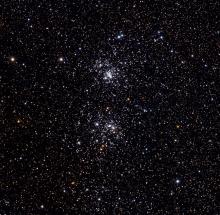Listen to today's episode of StarDate on the web the same day it airs in high-quality streaming audio without any extra ads or announcements. Choose a $8 one-month pass, or listen every day for a year for just $30.
You are here
Rogue Clusters
Perseus, the celestial hero, stands well up the eastern sky by mid-evening on November nights. When we gaze that way, we’re looking toward the outskirts of the Milky Way galaxy.
Perseus harbors some amazing sights far beyond the Milky Way’s borders. That includes the Perseus cluster of galaxies, which is about 250 million light-years away. And astronomers recently discovered that the cluster is home to thousands of rogue star clusters — clusters that aren’t attached to any galaxy.
The star clusters are globulars, so named because each is shaped like a globe. A typical globular cluster packs hundreds of thousands of stars into a sphere just a few dozen light-years across. The Milky Way has about 160 known globular clusters, which look like glittering cities of stars.
The brightest galaxy in the Perseus cluster boasts an astonishing 13,000 globulars. But astronomers using Hubble Space Telescope recently discovered globular clusters between the galaxies. Each intergalactic star cluster probably once lived in a galaxy. As the galaxies skirted past one another, though, their gravitational pull yanked the star clusters away from their parent galaxies.
As a result, these orphan star clusters now drift homeless between the galaxies of Perseus. In all, the galaxy cluster has roughly 50,000 globular star clusters that have lost their homes — testimony to how the lives of galaxies can alter the lives of their stars.
Script by Ken Croswell




